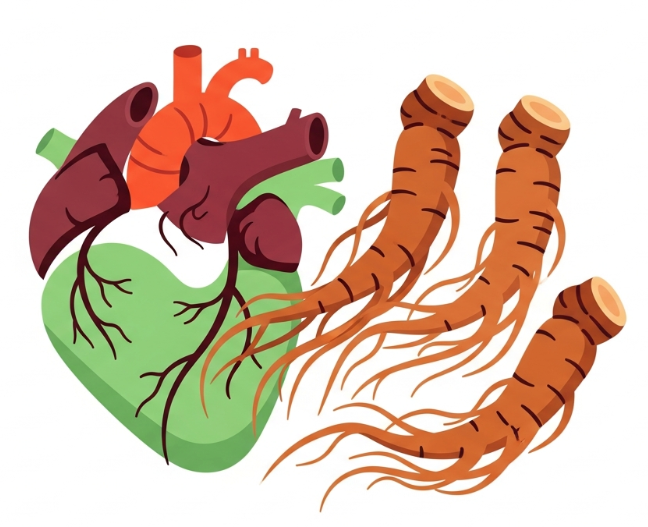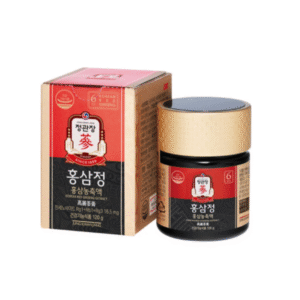Cardiovascular health has become one of the world’s top concerns, with high cholesterol, hypertension, and arterial stiffness ranking among the leading causes of heart disease. While statins remain the standard pharmaceutical therapy, many are now seeking natural, evidence-based approaches to complement modern treatment — and Korean Red Ginseng (Panax ginseng C.A. Meyer) stands out as one of the most studied botanical solutions for heart health.
🌿 What Makes Korean Red Ginseng Unique
Korean Red Ginseng is the steamed and dried form of Panax ginseng, rich in ginsenosides, polyphenols, and saponins — bioactive compounds shown to influence lipid metabolism, vascular function, and oxidative balance.
Modern research reveals that ginsenosides such as Rb1, Rg3, Rg5, and Re act on key biological pathways regulating cholesterol synthesis, blood vessel dilation, and endothelial protection, giving ginseng a multifaceted cardioprotective profile.
👉 Reference: Journal of Ginseng Research, 2022 – Cardiovascular Effects of Ginseng Bioactives
🫀 Understanding Cholesterol and Cardiovascular Risk
Cholesterol itself isn’t inherently harmful — it’s essential for cell structure and hormone synthesis. Problems arise when there’s an imbalance between LDL (low-density lipoprotein) and HDL (high-density lipoprotein), especially when LDL oxidizes and forms plaque inside arteries.
| Cholesterol Type | Role | Optimal Level |
|---|---|---|
| LDL (“bad”) | Delivers cholesterol to tissues; excess causes buildup | < 100 mg/dL |
| HDL (“good”) | Removes excess cholesterol from arteries | ≥ 60 mg/dL |
| Triglycerides | Energy storage; too high increases heart risk | < 150 mg/dL |
When LDL rises and HDL drops, inflammation and oxidative stress accelerate arterial damage — leading to atherosclerosis, hypertension, and coronary heart disease.
🌸 How Korean Red Ginseng Supports Healthy Cholesterol
1. Regulates Lipid Metabolism and Cholesterol Synthesis
Ginsenosides directly influence enzymes like HMG-CoA reductase — the same enzyme targeted by statin drugs. Unlike statins, however, ginseng modulates rather than blocks this pathway, promoting balance without severely disrupting the body’s natural synthesis.
→ Study: Nutrients, 2021 – Panax Ginseng and Lipid Regulation
✅ Result: Significant reductions in total cholesterol and LDL, with mild increases in HDL after 8–12 weeks of supplementation.
2. Improves HDL and Triglyceride Balance
In clinical trials, Korean Red Ginseng extract improved HDL by 8–12% and reduced triglycerides by up to 15%, particularly in adults with mild hyperlipidemia. The mechanism involves activation of AMP-activated protein kinase (AMPK) — the same energy-regulating enzyme stimulated during exercise.
✅ Result: Enhanced lipid clearance, better fat oxidation, and improved overall metabolic flexibility.
3. Protects Blood Vessels and Enhances Circulation
Endothelial dysfunction (when blood vessels can’t dilate properly) is an early marker of heart disease. Ginsenosides stimulate nitric oxide (NO) synthesis, improving vascular elasticity and promoting smoother circulation.
→ Reference: Frontiers in Pharmacology, 2020 – Nitric Oxide Modulation by Ginsenosides
✅ Result: Lower blood pressure, improved oxygen delivery, and reduced arterial stiffness — all key to long-term heart health.
4. Reduces Oxidative Stress and Arterial Inflammation
Oxidized LDL (ox-LDL) is particularly dangerous because it triggers inflammation within artery walls. Korean Red Ginseng’s antioxidant compounds — including polyacetylenes and maltol derivatives — neutralize free radicals and inhibit ox-LDL formation.
→ Study: Antioxidants, 2021 – Red Ginseng and Vascular Oxidative Stress
✅ Result: Less plaque buildup, improved arterial clarity, and protection from long-term cardiovascular damage.
5. Supports Blood Pressure and Microcirculation
High cholesterol and hypertension often occur together. Ginseng has mild vasorelaxant effects, helping dilate blood vessels and lower peripheral resistance. This mechanism supports smoother blood flow and oxygen delivery, reducing the workload on the heart.
→ Clinical Trial: Participants with mild hypertension taking 2 g/day of Korean Red Ginseng extract for 12 weeks saw a mean systolic blood pressure reduction of 7–10 mmHg without side effects (Phytotherapy Research, 2020).
✅ Result: Dual benefit — supports both cholesterol and blood pressure management.
⚖️ Korean Red Ginseng vs. Statins: Complementary, Not Competitive
Statins like simvastatin and atorvastatin remain essential for many with high cardiovascular risk. They work by blocking HMG-CoA reductase, sharply reducing cholesterol production in the liver.
However, long-term statin therapy can lead to muscle pain, fatigue, or liver enzyme elevations in some patients.
Korean Red Ginseng, by contrast, offers gentler modulation — supporting healthy lipid metabolism while delivering additional antioxidant, adaptogenic, and vasodilatory benefits.
🧠 Clinical Comparison (Educational Context)
| Feature | Statins | Korean Red Ginseng |
|---|---|---|
| Primary mechanism | Inhibits HMG-CoA reductase | Modulates lipid metabolism via AMPK & partial HMG-CoA pathways |
| LDL reduction | 25–60% | 10–20% (mild to moderate) |
| HDL improvement | Minor | Moderate (8–12%) |
| Antioxidant effect | Limited | Strong |
| Adaptogenic stress protection | No | Yes |
| Safety | Effective but can cause side effects in some | Well-tolerated in adults |
Conclusion: Korean Red Ginseng may serve as a complementary therapy for those under medical supervision — not a replacement for prescribed medication, but a scientifically backed natural aid for improving heart resilience and metabolic health.
🩺 Dosage and Safety Guidelines
- Suggested daily intake: 200–400 mg of standardized Korean Red Ginseng extract (3–5% ginsenosides)
- Duration: 8–12 weeks for lipid and vascular improvements
- Form: Capsule, powder, or liquid tonic
- Best taken: Morning, before meals, for optimal absorption
💡 Caution: Always consult a healthcare professional before combining ginseng with statins, blood thinners, or antihypertensive medications.
→ Safety Reference: Phytomedicine, 2019 – Long-Term Safety of Panax Ginseng
❤️ The Holistic Heart Benefits of Korean Red Ginseng
- Balances LDL, HDL, and triglycerides naturally
- Protects arteries from oxidative and inflammatory damage
- Enhances nitric oxide for better circulation
- Supports heart muscle endurance and oxygenation
- Promotes calm energy and stress resilience — key for cardiac recovery
→ Summary Insight: Regular intake of Korean Red Ginseng may reduce the risk factors associated with heart disease, improve vascular flexibility, and enhance overall energy metabolism, aligning with the modern integrative approach to cardiovascular wellness.
🌿 Conclusion
Korean Red Ginseng offers a powerful natural approach to maintaining healthy cholesterol and heart function — supported by decades of clinical and molecular research. While not a replacement for medical treatment, it provides a scientifically grounded option for preventive cardiovascular care and metabolic balance.
Incorporating it into your lifestyle — alongside proper diet, exercise, and medical supervision — can support a stronger, more resilient heart for years to come.
🇰🇷 Premium Korean Ginseng Online Shop







